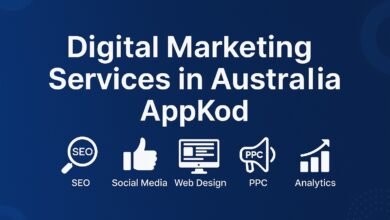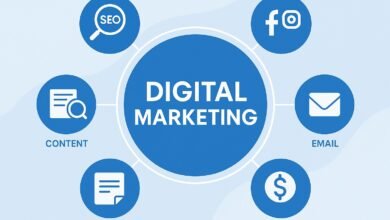Understanding Internet Marketing: An In-Depth Guide to Types and Strategies

Introduction to Internet Marketing
Internet marketing, also known as online marketing or digital marketing, encompasses a variety of strategies that promote products or services through digital channels. As the world increasingly moves toward a digitally-dominated landscape, the significance of internet marketing continues to escalate. It allows businesses to reach a broader audience, engage with customers more personally, and effectively track the success of their marketing efforts.
One of the principal distinctions between internet marketing and traditional marketing lies in the methods employed to reach consumers. Traditional marketing often relies on offline methods such as print ads, television commercials, and direct mail, which can limit the ability to target specific demographics. In contrast, internet marketing utilizes online platforms such as social media, search engines, email, and websites, enabling marketers to hone in on their desired audience with precision. This targeted approach helps maximize the impact of marketing efforts while minimizing costs.
Moreover, the advent of advanced analytics tools in internet marketing allows businesses to monitor their campaigns and measure performance in real-time. This data-driven approach enhances decision-making, as companies can tailor their strategies based on consumer behavior and preferences. Consequently, adapting to customer needs not only fosters brand loyalty but also increases conversion rates, ultimately leading to higher revenue.
As businesses increasingly recognize the vital role of internet marketing in achieving their goals, incorporating online marketing strategies becomes essential. This shift is not merely a trend but rather a fundamental evolution in how products and services are promoted. By embracing the digital landscape, businesses can unlock new opportunities for growth and success that were previously unattainable through traditional marketing methods.
Social Media Marketing
Social media marketing has emerged as a critical component of internet marketing strategies aimed at engaging with audiences across diverse platforms such as Facebook, Twitter, and Instagram. By leveraging the unique features and user bases of these platforms, businesses can effectively communicate their brand message and foster meaningful relationships with consumers. The essence of social media lies in its capacity to create dialogue between the brand and its audience, making it an invaluable tool for building brand awareness and driving traffic.

To begin with, defining a clear social media marketing strategy is paramount. This involves identifying target demographics and selecting the most suitable platforms to reach them. Each platform caters to different audiences and content types; for instance, Instagram is highly visual, making it ideal for brands with strong imagery, whereas Twitter excels in real-time updates and conversations. Understanding these characteristics enables businesses to tailor their content effectively, ensuring that it resonates with their intended audience.
Building brand awareness is one of the primary objectives of social media marketing. Engaging content that encourages sharing and interaction can significantly elevate a brand’s visibility. Techniques such as running contests, utilizing hashtags, and collaborating with influencers can amplify reach. Furthermore, social media platforms provide analytics tools that allow marketers to gauge engagement rates, helping them refine their strategies for optimum effectiveness.
Driving traffic to websites is another essential goal of social media marketing. Incorporating clear calls-to-action in posts and utilizing link shorteners can guide potential customers directly to relevant web pages. Moreover, consistent posting and engagement with followers help to establish a loyal community around the brand, ultimately leading to higher conversion rates.
In conclusion, social media marketing plays a vital role in internet marketing by strengthening customer relationships, enhancing brand visibility, and driving website traffic. By implementing effective strategies and fostering genuine interactions, businesses can leverage social media to achieve their marketing objectives successfully.
Email Marketing
Email marketing remains one of the most effective tools in the realm of internet marketing, primarily due to its direct and personalized approach. By engaging customers through their inboxes, businesses can nurture leads, maintain customer relationships, and even foster loyalty. The key lies in understanding how to craft compelling email campaigns that resonate with the target audience while delivering meaningful content.

To begin with, the effectiveness of email marketing is significantly enhanced through segmentation. By dividing subscribers into specific groups based on demographic information, past purchases, or engagement patterns, marketers can tailor content that speaks directly to the interests and needs of each segment. This targeted strategy not only improves open and click-through rates but also reduces the likelihood of subscribers unsubscribing from communications.
Personalization is another crucial element in successful email marketing. Recipients are more likely to engage with content when it feels unique to them. This can be achieved through personalized subject lines, customized recommendations, and relevant follow-up messages. By addressing the recipient by their name and discussing their preferences or past interactions, brands can create a more engaging and meaningful experience.
Additionally, leveraging analytics plays a vital role in email marketing strategies. Monitoring open rates, click rates, and conversion rates provides invaluable insights into what works and what does not. Tools and software tailored for internet marketing can help businesses interpret this data to refine their strategies further. Regular A/B testing allows marketers to experiment with different designs, subject lines, and content types, ensuring continuous improvement of their campaigns.
In conclusion, successfully executing email marketing involves strategic segmentation, personalization, and analytics to create resonant communication that nurtures leads and strengthens customer relationships. By adhering to these best practices, brands can optimize their email campaigns and harness the full potential of this powerful internet marketing tool.
Content Marketing
Content marketing has emerged as a pivotal strategy in the realm of internet marketing, focusing on the creation and distribution of valuable, relevant content aimed at attracting and retaining a clearly defined audience. The primary goal is to foster customer engagement and drive profitable consumer action through the delivery of high-quality information that addresses the needs and interests of potential customers. By offering insight, expertise, and entertainment, brands can build trust and establish themselves as authorities within their industries.

There are various forms of content utilized in effective content marketing campaigns. Blog posts serve as one of the most common tools, allowing brands to provide in-depth articles that respond to customer queries or delve into industry trends. Infographics, which present information visually, can simplify complex data, making it more digestible for the audience and more likely to be shared. Videos have also gained significant traction, offering dynamic and engaging content that appeals to visual learners and helps convey messages more effectively. By leveraging these different content types, businesses can reach a broader audience and cater to diverse preferences.
Distribution strategies are equally essential in enhancing the efficacy of content marketing. Utilizing social media platforms can significantly expand the reach of content, allowing brands to engage directly with their audience through shares, comments, and interactions. Email newsletters can also be employed to deliver tailored content directly to subscribers, fostering a more personal relationship with potential customers. Furthermore, search engine optimization (SEO) practices help in improving content visibility on search engines, driving organic traffic and increasing the chances of conversion. Overall, effective content marketing harnesses various formats and distribution channels to maximize customer engagement and sustain long-term relationships.
Search Engine Marketing (SEM)
Search Engine Marketing (SEM) is a critical component of internet marketing that encompasses both Search Engine Optimization (SEO) and Pay-Per-Click (PPC) advertising. Its primary objective is to increase a website’s visibility on search engine results pages (SERPs) through organic and paid strategies. To effectively utilize SEM, businesses need to understand how these two methods function individually and collectively.

SEO focuses on optimizing website content and structure to rank higher in organic search results. It involves a variety of techniques such as keyword research, on-page optimization, backlinking, and improving user experience. By selecting the right keywords that potential customers use, businesses can optimize their web pages to fulfill search intent, thereby enhancing their organic visibility. Furthermore, keeping updated with search engine algorithms is crucial, as these changes can significantly impact one’s ranking.
PPC, on the other hand, is a paid advertising model that allows businesses to display ads on SERPs. Advertisers bid on keywords relevant to their products or services, and ads are displayed based on their bid amount and quality score. With PPC, businesses can achieve immediate visibility and drive traffic to their sites, which is particularly useful for promotions or new product launches. It also allows for targeted advertising, ensuring that only users who are interested in a particular product or service see the ads, thus increasing the likelihood of conversions.
Incorporating both SEO and PPC in an internet marketing strategy can yield substantial benefits. By leveraging the strengths of both methods, businesses can create a comprehensive strategy that not only increases website traffic but also enhances the likelihood of converting visitors into customers.
Influencer Marketing
Influencer marketing has emerged as a pivotal element of successful internet marketing strategies, enabling businesses to harness the power of social media personalities to engage with wider audiences effectively. Influencers, individuals who have established credibility and a loyal following within a specific niche, can serve as valuable conduits between brands and potential customers. By collaborating with these key opinion leaders, companies can gain access to targeted demographics and enhance their visibility in an increasingly crowded marketplace.

When identifying the right influencers for a marketing campaign, brands must consider several factors such as relevance, reach, and engagement rates. Relevance entails ensuring that an influencer’s content aligns with the brand’s values and target audience. This is crucial, as partnerships that resonate authentically with potential customers are likely to yield better results. Additionally, reach refers to the size of the influencer’s audience; however, engaging micro-influencers—those with smaller, more dedicated followings—can often lead to higher engagement rates and conversion levels than their more prominent counterparts. Lastly, brands should evaluate the engagement rate of influencers, which is a measure of how actively their audience interacts with the content, including likes, comments, and shares.
Measuring the success of influencer marketing campaigns is essential for continuous improvement and ROI assessment. This can be accomplished through various metrics, such as tracking referral traffic to the brand’s website, monitoring sales generated through unique promotional codes, and analyzing social media metrics following the campaign launch. Additionally, feedback from customers can offer qualitative insights into the impact of these collaborations. By integrating these measurements into their overall internet marketing strategy, businesses can fine-tune their influencer partnerships, ensuring that they drive substantial results and align with their overarching marketing objectives.
Mobile Marketing
In the current digital landscape, mobile marketing has become an essential facet of internet marketing strategies. With the growing reliance on smartphones, it is crucial for businesses to adopt effective mobile marketing techniques that cater to the needs of mobile users. A primary component of mobile marketing is the development of mobile-friendly websites. These sites are optimized for smaller screens and touch interfaces, ensuring a seamless user experience. It is important for businesses to recognize that a significant portion of their target audience accesses information via mobile devices, making responsive design a priority.

Mobile applications present another powerful avenue for enhancing customer engagement. Through tailored apps, businesses can provide users with a platform that offers personalized content, easy navigation, and unique features not available on their websites. These apps can facilitate direct communication with users through push notifications, fostering ongoing engagement with the brand. By leveraging data from app usage, businesses can fine-tune their marketing strategies, ensuring they meet the evolving preferences of their customers.
SMS marketing is also an impactful tool within mobile marketing strategies. By sending targeted text messages to customers, businesses can share promotions, reminders, and special offers directly to their audience’s mobile devices. This form of instantaneous communication can significantly enhance customer engagement and drive traffic. Additionally, location-based services enable businesses to target consumers in specific geographical areas, offering them tailored promotions as they pass by a store or enter a designated locale. This strategy not only improves the relevance of marketing messages but also enhances the likelihood of in-store visits.
As mobile marketing continues to evolve, businesses must stay abreast of the latest trends and technologies to effectively engage the growing population of mobile users. By developing mobile-friendly websites, creating dedicated apps, implementing SMS marketing, and utilizing location-based services, companies can improve their overall internet marketing efforts and connect with customers in meaningful ways.
Online Advertising and Paid Advertising
Online advertising has emerged as a cornerstone of internet marketing, offering businesses a range of strategies to connect with their target audiences. Among the most common forms of online advertising are banner ads, pay-per-click (PPC) campaigns, and display advertising. Each of these methods utilizes different approaches to capture consumer attention and drive traffic to websites.

Banner ads are visual advertisements that are displayed on websites. They often appear at the top, bottom, or side of a webpage and serve to promote products, services, or brand awareness. One of the primary advantages of banner ads is their ability to create immediate brand recognition, as they can be visually appealing and engaging. Effective banner ads often feature eye-catching graphics and concise messaging to attract viewers’ attention.
Pay-per-click (PPC) campaigns, on the other hand, allow businesses to pay only when a user clicks on their advertisement. This model applies to various platforms, including search engines and social media. PPC is particularly advantageous for businesses looking for measurable results, as it allows for tracking conversions and return on investment (ROI). By leveraging keyword research and targeting specific demographics, marketers can optimize their campaigns to ensure that ads are displayed to the most relevant audiences.
Display advertising encompasses a broader range of visual ads, including video ads, interactive ads, and rich media formats. These ads can appear on various websites within an ad network, allowing businesses to reach a diverse audience across multiple platforms. The creative potential of display advertising enables companies to experiment with different formats to determine what resonates best with their audience.
In conclusion, online advertising and paid advertising strategies play a pivotal role in the realm of internet marketing. By understanding the different types of online ads available and their unique advantages, businesses can create effective ad campaigns that engage audiences and drive tangible results.
Measuring Success in Internet Marketing
Measuring the success of internet marketing strategies is crucial for businesses aiming to optimize their marketing efforts and achieve a significant return on investment (ROI). Understanding key performance indicators (KPIs) is foundational in assessing the effectiveness of various digital tactics. These metrics can provide insights into the performance of campaigns across different channels, helping marketers make informed decisions.
Common KPIs in internet marketing include website traffic, conversion rates, click-through rates (CTR), and engagement metrics such as time on site and bounce rates. Each of these indicators offers a distinct perspective on how well marketing strategies are functioning. For instance, an increase in website traffic may reflect effective SEO efforts or successful content marketing strategies, while higher conversion rates indicate that the messaging resonates well with the audience.
In addition to these traditional metrics, utilizing analytic tools can significantly enhance the measurement of internet marketing success. Platforms like Google Analytics provide comprehensive data related to user behavior, allowing marketers to drill down into how different segments of the audience interact with their content. This data can inform adjustments in strategy, ensuring that marketing efforts are aligned with user preferences and trends.
Social media analytics offer a different set of insights that can be valuable for a more holistic understanding of marketing performance. Metrics such as likes, shares, and comments can reveal the level of consumer engagement and brand awareness achieved through social channels. Furthermore, email marketing tools can provide open rates and click-through statistics that are indispensable for evaluating the effectiveness of email campaigns.
Overall, tracking these KPIs and employing the right tools will enable businesses to measure the effectiveness of their internet marketing strategies, ultimately leading to a more optimized and profitable marketing approach.



